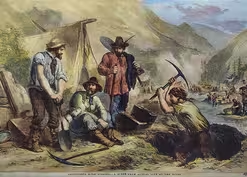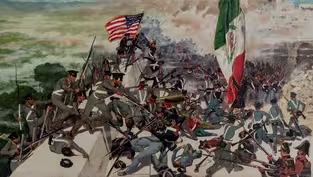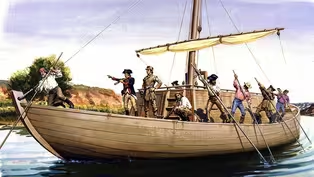
The Trail of Tears
Season 2 Episode 2 | 12m 41sVideo has Closed Captions
Learn about the history of the Indian Removal Act and the Trail of Tears.
This edition of History In A Nutshell briefly elaborates on the history of President Andrew Jackson's "Indian Removal Act", and the hardships on the "Five Civilized" Native American tribes it caused.
Problems playing video? | Closed Captioning Feedback
Problems playing video? | Closed Captioning Feedback
History in a Nutshell is a local public television program presented by SCETV

The Trail of Tears
Season 2 Episode 2 | 12m 41sVideo has Closed Captions
This edition of History In A Nutshell briefly elaborates on the history of President Andrew Jackson's "Indian Removal Act", and the hardships on the "Five Civilized" Native American tribes it caused.
Problems playing video? | Closed Captioning Feedback
How to Watch History in a Nutshell
History in a Nutshell is available to stream on pbs.org and the free PBS App, available on iPhone, Apple TV, Android TV, Android smartphones, Amazon Fire TV, Amazon Fire Tablet, Roku, Samsung Smart TV, and Vizio.
Providing Support for PBS.org
Learn Moreabout PBS online sponsorshipMore from This Collection
A collection chronicling some of the most significant chapters of westward expansion in the United States.
Video has Closed Captions
Learn how the discovery of gold in California transformed the American west! (14m 40s)
Video has Closed Captions
Learn how President James K. Polk acquired Mexico's northern territories in the 1840's! (13m 44s)
The Lewis and Clark Expedition
Video has Closed Captions
Watch a brief expose on the history of Lewis and Clark's "Corps of Discovery"! (29m 46s)
Providing Support for PBS.org
Learn Moreabout PBS online sponsorship♪ solemn music ♪ (writing sounds) ♪ Greetings, everyone.
Welcome to another edition of History In A Nutshell.
The subject of this episode covers one of the darkest and most controversial chapters of western expansion in the United States, the forced exile of Native American tribes from the eastern states known today as the "“Trail of Tears"”.
What began as an experiment of peaceful coexistence between Native Americans and their White neighbors, the desire for land and wealth gradually overshadowed the plights of American Indians, and as a result the majority of Native Americans were forcibly moved to designated Indian territories west of the Mississippi River.
While some left to go west voluntarily, many others died on the forced journey west, suffering disease, harsh weather, frostbite, and starvation.
How was this allowed to happen?
Join me as we take a look into the history of the Trail of Tears.
Before their forced removal from the southeast, the five main tribes living in the region were the Choctaw, Chickasaw, Seminole, Creek, and the Cherokee.
While relations between these tribes were not always peaceful, they all believed they had the right to live on the land of their ancestors.
European settlers began arriving in "“The New World"” in the early 1500's, and the aforementioned tribes became known as the "“Five Civilized Tribes"” for their relatively peaceful interactions with these early settlers.
As the number of settlers from different European countries increased throughout the 17th and 18th centuries, conflicts between these White settlers and their Native American neighbors occurred.
American Indians living in the 13 colonies would be forced to pick sides in conflicts such as the French and Indian War and the American Revolutionary War.
Many Native American tribes, like the Cherokee, for example, sided with the British in the Revolution due to Britain's desire to limit encroachment onto native lands; a direct contrast from American colonists who were eager to expand westward.
After America gained independence from Great Britain, those tribes who sided with the British paid dearly for being on the losing side They were treated as conquered nations, and Americans felt justified in taking the land away from them.
The newly formed United States faced a new challenge: how would its citizens live among the Native Americans?
President George Washington collaborated with Secretary of War, Henry Knox to come up with a solution.
Washington and Knox held the sentiment that if the Native Americans were going to coexist peacefully with White citizens, they must become a civilized people.
The American policy of "“civilization"” was implemented - it was believed at that time that if American Indians could adopt the traditions and customs of their White neighbors, then they would be treated as equals in American society.
Christian missionaries were sent to Native American tribes to teach them things like how to dress, how to speak the English language, and new methods of farming.
Many Native Americans were willing learners who adapted to civilization quickly; some became wealthy plantation owners, even owning enslaved Africans to maintain their land and crops.
Despite these efforts of civilization, many American settlers still desired more land, and pressured the federal government to deal with the "“Indian Problem"”.
By 1830, the United States had 24 states, and a population around 13 million people.
The country was growing, and as the United States increased in size, the demand for Native American tribes to make more room for the White settlers also increased.
During this period, the federal government tried to persuade these tribes to voluntarily go west of the Mississippi River.
While some did leave, many others refused since they believed they had the right to live there like their ancestors before them.
Two key events in 1828 would instigate the definite Native American removal in the east: the discovery of gold in Georgia, and the election of President Andrew Jackson.
Many White settlers in the south wanted the Native Americans gone, and with President Jackson in office, they would get what they had been waiting for.
The removal of American Indians was the Jackson administration's first priority.
On May 26, 1830, the Indian Removal Act was passed.
Two years later in 1832, the state of Georgia had divided up land owned by the Cherokees which contained gold with the Georgia Lottery - Georgians purchased $18 "“draws"” for a chance to win 160 acre lots.
There were 18,000 lots, and over 85,000 people purchased these draws.
As winners were announced, the American Indians living in those lots were forced to leave.
Naturally, this action further emboldened Georgia's citizens to encroach on Cherokee land.
These actions did not come without resistance.
Some in the north, and congressman Davy Crockett from Tennessee were outspoken in their opposition to Jackson's plan.
The Seminole tribe in Florida openly fought back against the American government in the Second Seminole War.
The Cherokees took a more legal approach, believing the fight could be won against President Jackson in the courts.
Out of more than a dozen court cases, two reached the United States Supreme Court The first case is Cherokee Nation v. Georgia: Principal Chief John Ross with the assistance of former Attorney General William Wirt argued the questions, Those questions eventually got answered in the second case Worcester v. Georgia in 1832.
Samuel Worcester was a missionary residing in the Cherokee nation.
Georgia authorities imprisoned Worcester for refusing to take an oath of allegiance.
Wirt argued that his arrest was unconstitutional, that Cherokee tribal laws could not be overridden by the state of Georgia.
The Supreme Court, led by Chief Justice John Marshall, ruled in favor of the Cherokee Nation, stating that the Georgia act interfered with federal law and was therefore unconstitutional.
Despite this victory for the Native Americans in the Supreme Court, President Jackson and the state of Georgia openly defied the Supreme Court order, refusing to enforce it.
Andrew Jackson issued an ultimatum: Native Americans will either obey the laws of their respective states or leave.
The situation for Native Americans became dire.
The main debate for them became "“should we leave, or should we stay and continue fighting for what's ours?
"” Some held out in the belief that the election of a new President would change the course of Native American history in the southeast, but those hopes were dashed when Jackson's successor, President Martin Van Buren continued the efforts toward Native American removal.
More small bands of Native Americans began to realize that their removal was inevitable and decided to leave.
Those who left voluntarily before their deadlines, those who had the means of leaving, were compensated by the federal government with money and land reserved for them.
For the majority of those still living in the southeast, leaving was not an option.
The Choctaw tribe was the first to be forcibly removed in 1831, followed by the Seminoles in 1832; the Creek in 1834 and the Chickasaw in 1837.
In 1838, under command of General Winfield Scott, federal troops and state militias marched into Cherokee territory and forced them out of their homes.
They were not even given time to pack any belongings.
Under force of arms, they were rounded up and herded into wooden cattle pens to await the journey west.
Small handfuls from each tribe were able to escape this fate if they renounced their native citizenship and swore allegiance to their respective states, but most did not.
Conditions for the Native Americans awaiting the transfer west were inhumane.
They were exposed to the elements and had to sleep on the ground.
They waited weeks, sometimes months in these pens before it was their time to go.
Many infants and the elderly died in this waiting period before their journeys west!
Even the enslaved Africans owned by the wealthier members of these tribes did not escape the fate of forced removal and had to suffer the journey with their owners.
The journey to the Indian Territory west of the Mississippi River was marked with hardship and sorrow.
Those who traveled in the summer months faced intense heat and diseases.
Those who traveled during the winter months, they suffered through sickness, starvation, freezing cold temperatures and frostbite.
For those who perished along the way?
Their families had barely any time to bury and mourn their loved ones before pressing on.
According to estimates, around 100,000 Native Americans were forced to leave their homes and endure this journey.
As many as 15,000 perished on these forced marches.
While the United States did gain a significant amount of land and capital, they came at a terrible cost.
No matter how one may look at it, the forced removal of Native Americans from the eastern United States will forever be a controversial, dark blot in U.S. history.
While these Native American tribes were able to rebuild and make new lives for themselves in the designated Indian Territory, their lives, history and culture would never be the same again.
♪
Support for PBS provided by:
History in a Nutshell is a local public television program presented by SCETV


















